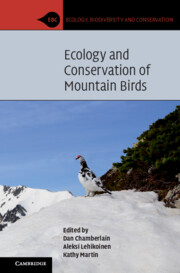Book contents
- Ecology and Conservation of Mountain Birds
- Ecology, Biodiversity and Conservation
- Ecology and Conservation of Mountain Birds
- Copyright page
- Contents
- Contributors
- Preface
- Acknowledgements
- 1 Mountain Birds and Their Habitats
- 2 Avian Adaptations to High Mountain Habitats
- 3 Global Bird Communities of Alpine and Nival Habitats
- 4 Birds of Treeline Ecotones
- 5 Population Trends of Mountain Birds in Europe and North America
- 6 Climate Change Impacts on Mountain Birds
- 7 Anthropogenic Activities and Mountain Birds
- 8 Modelling Large-Scale Patterns in Mountain Bird Diversity and Distributions
- 9 The Alpine Avifauna of Tropical Mountains
- 10 Priorities for Information, Research and Conservation of Birds in High Mountains
- Bird Species Index
- Subject Index
- Plate Section (PDF Only)
- References
10 - Priorities for Information, Research and Conservation of Birds in High Mountains
Published online by Cambridge University Press: 30 June 2023
- Ecology and Conservation of Mountain Birds
- Ecology, Biodiversity and Conservation
- Ecology and Conservation of Mountain Birds
- Copyright page
- Contents
- Contributors
- Preface
- Acknowledgements
- 1 Mountain Birds and Their Habitats
- 2 Avian Adaptations to High Mountain Habitats
- 3 Global Bird Communities of Alpine and Nival Habitats
- 4 Birds of Treeline Ecotones
- 5 Population Trends of Mountain Birds in Europe and North America
- 6 Climate Change Impacts on Mountain Birds
- 7 Anthropogenic Activities and Mountain Birds
- 8 Modelling Large-Scale Patterns in Mountain Bird Diversity and Distributions
- 9 The Alpine Avifauna of Tropical Mountains
- 10 Priorities for Information, Research and Conservation of Birds in High Mountains
- Bird Species Index
- Subject Index
- Plate Section (PDF Only)
- References
Summary
High mountains cover an estimated 25% of the global land surface, but harbour almost 50% of terrestrial biodiversity hot-spots and about one-third of terrestrial biodiversity globally. Thus, it is concerning that relatively little research has been conducted on birds in high mountains, especially for tropical mountain birds. We identified 10 major knowledge gaps arising from the reviews in our nine previous chapters, including the urgent need for information on avian diversity and population and community ecology, especially in under-studied mountains of the Global South, avian responses to climate change and other stressors, mountains as refugia from habitat and climate change, and the role of protected areas to function as biodiversity reservoirs. We propose a set of priorities for ecological and conservation research and management that will help to ensure persistence of birds in high mountain ecosystems. Maintaining and restoring mountain biodiversity is important from ecological, evolutionary and cultural points of view. We recommend investing in research to safeguard the critical ecological, social and economic values of mountain systems into the future. Strong support is needed from the scientific community, citizen scientists, policy makers, politicians and local communities to fulfill our priorities for the conservation of mountains and mountain birds.
Keywords
- Type
- Chapter
- Information
- Ecology and Conservation of Mountain Birds , pp. 372 - 406Publisher: Cambridge University PressPrint publication year: 2023
References
- 1
- Cited by



